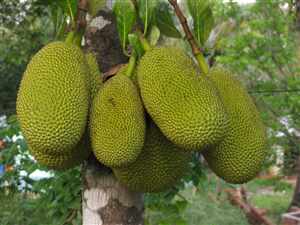Jackfruit (Artocarpus heterophyllus), Baddac
Main Facts about Jackfruit

Using Jackfruit
The Jackfruit is made of easily digestible flesh; a 100-g portion of raw Jackfruit provides about 95 calories and about 13.7 mg of vitamin C. Jackfruit seeds are rich in protein. Further, fresh fruit is a good source of vitamin B6, potassium, calcium, magnesium, manganese, and iron. Jackfruit is a source of dietary fiber, which makes it a good laxative. Unripe Jackfruit has a texture remarkably similar to chicken, making it an excellent vegetarian substitute for meat. Jackfruit is sometimes referred to as "vegetable meat". Traditionally, Jackfruit was considered a tonic because of high concentration of vitamin C and iron . Jackfruit helps to alleviate anemia. It strengthens immune function and protects from could, cold, flu, and infections. It provides a quick energy boost without significant changes to the sugar levels in the body. Being a good source of potassium, Jackfruit is good against high blood pressure. Eating Jackfruit also keeps skin moisturized due to high level of water content in it. Being an excellent source of vitamin A, Jackfruit help preventing vision-related problems like macular degeneration and night blindness. The Jackfruit root has been found to be an effective remedy for asthma.Jackfruit is a remedy for: Cold and flu, Constipation, Hemorrhoids
Caution!
Even in India there is the belief that overindulgence in Jackfruit causes digestive ailments. The ripe fruit is laxative; if eaten in excess it will cause diarrhea. Raw Jackfruit seeds are indigestible. Do not eat Jackfruit if you have diabetes because itt can change the tolerance capacity of glucose in the body. Do not eat the seeds if you are undergoing therapy for immunosuppresison because these seeds are immunostimulative. Do not eat if you have birch pollen allergy. Do not eat if you are taking blood thinners or aspirin.Cooking with Jackfruit
Jackfruits can be dried, roasted, added to soups, used in chips, jams, juices, ice cream. The seeds can be boiled, roasted or ground into flour.How to grow Jackfruit
The Jackfruit tree grows in tropical and subtropical climates. It should have a well-drained, frost-free location that is sunny and warm. It needs rich soil of medium or open texture. The tree is sensitive to frost in its early life and does not tolerate drought. Propagation is usually by seeds, which can be kept no longer than a month before planting. Germination requires 3 to 8 weeks. Jackfruits mature 3 to 8 months from flowering. When mature, there is usually a change of fruit color from light green to yellow-brown.| Hyssop |
Jiaogulan
|